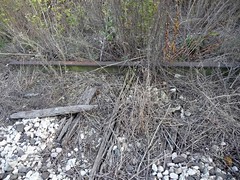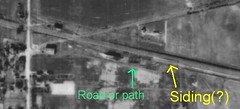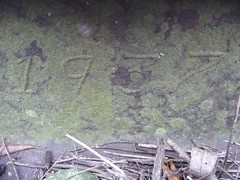
(Click on image to enlarge)
You can still find the remains of a siding on the south side of the Grand Trunk Railroad, east of the Ainsworth crossing. Where the siding originally departed from the main tracks, I do not know, but you start picking up its traces about 40 feet west of the Ainsworth tower; it passes between the tower and the main tracks and extends eastward toward Grand Boulevard, then is swallowed up by thick underbrush and trees, and further obscured by the effects of heavy equipment used to make a gravel road to the tower for use by maintenance crews.
When and why it was built, I do not know. Looking at the 1939 aerial photos, I do see something approximately where the remains of the siding are now; and there is a road or path worn from the buildings south of the tracks to that something.

(Click on image to enlarge)
On the other hand, these aerial photos are not great on ground-level detail, and the possible siding looks shorter than the remains would suggest. So I'm not 100% sure.
On the third hand, when I run across a newspaper article from 1890 saying that the Indiana Natural Gas Pipeline "has large amounts of pipes received at Ainsworth, Ind." [Logansport Pharos (Logansport, Ind.), Sept. 2, 1890], I wonder how the unloading of "large amounts of pipes" would be done. Did it involve uncoupling cars full of pipes and leaving them on the siding?
*sigh* I suppose I have to go research how large railroad shipments were unloaded in small towns in the 1890s. Or I could just wait for the information to fall into my lap.
When and why the siding was abandoned, I do not know, either. At some point the railroad removed the switching mechanism that made it possible to divert equipment onto the siding; there is absolutely no trace of it now.
ETA (9/30/09): I found what appears to be a manufacturer's date stamp on one of the siding rails:

(Click on image to enlarge)
A manufacture date of 1937 suggests that we are indeed looking at the siding on the 1939 aerial photo. It doesn't mean the siding itself was built in 1937, of course, because I found rails on the main tracks nearby dated 2004 and 1996, and we all know the railroad dates back to 1880.
That was the only date I could find. The other rails were either so buried in vegetation that I couldn't get down to ground level to look at their sides (I may try again in late winter) or were so heavily rusted that their markings were illegible.


3 comments:
Almost all segments of railroad track have a date stamped somewhere along its length, usually including the name of the manufacturer and sometimes even the initials of the railroad. You'll find these marking below the railhead and above the flared base of the rail that rests on the ties.
It's often harder to see on old rails because of the rust, discoloration and accumulated weeds and debris, but chek it out, you'll probably find it.
Another point: Sure, if Ainsworth once rated a station, it almost certainly rated a siding where the railroad could set out loaded cars. No way would a train stop on the main track to go through the laborious process of loading or unloading one or more cars.
Thanks for the info! I will check those rails next time I'm up there.
Post a Comment